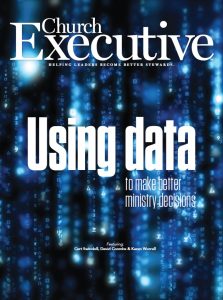
Our goal with this discussion is to focus on the most relevant data points that can gauge the health of your ministry.
Our panelists will also focus on how innovative churches are making their decisions through data — and the ways to enrich an empowered discipleship by leveraging technology.

Executive Vice President
Pursuant
What are some of the most important data points church leaders should pay attention to that they might not realize?
Coombs: Several years ago, we developed a mission statement and the measures to watch and see if we’re meeting that mission statement. We call this our ‘vision frame,’ and we look through this frame to these measurements to set our program, as well as to measure our results. Some of those measurements under our mission statement — which is to love God, love people, share Jesus and make disciples — are measurements which we can quantitatively get some information from and monitor from our church management system. One of the measurements of ‘love people’ is to be involved in a life group. We track extensively our life group attendance and the percentage and level of participation. One of the measurements under ‘love God’ is giving compassionate care to others at Bellevue. We measure that as far as our in-reach program, and how many people are volunteering in various ministries within our church.
Worrell: I try to look at the numbers in a granular level. We try to reach people before they become unreachable. We notice classes that are declining in attendance, and we may step in and help them to learn how to use the management tool, such as TouchPoint, to reach those people more affectively. We want the lay leaders to be

Administrative Pastor
Bellevue Baptist Church
able to reach out to the correct people and do what is necessary to get them pulled back in.
Swindoll: We might want to expand our thinking around what is a data point. Many people think in terms of financial information, because we’re typically reviewing financials as leaders of churches and organizations. But, there are many examples of non-financial information that are important to pay attention to.
I would challenge church leaders to think in terms of what are the things that they value in their environment. Then you have to ask, If we value these things, then what kind of behavior, engagement or interaction will be the evidence that people are operating in accordance with these values?

Systems Administrator
TouchPoint Software
How can church leaders use data in their church management systems to enhance the discipleship process?
Worrell: We use our data to tell us where people are entering our database, why they have a record there, and what they’re attending first. Then we can use that to enhance discipleship efforts. Maybe someone enters because they registered for a recreation team, or they may have come through the women’s ministry. We use that data, then, to message them about other opportunities. We track all of this in order to be intentional with our discipleship.
Coombs: We consistently look through our measurement window that we start with our mission, our measures, our values, and then our strategy. One of these measures is making disciples.
The first measurement point is being personally accountable to other Christians. We measure that by the percentage of our membership that’s in a discipleship or life group on a weekly basis.
The next point is being involved in equipping environments. We have multiple classes on Wednesday night to equip our people. We measure attendance and what percentage of involvement they’re giving.
The next thing is multiplying disciple-makers. We started developing an attention on discipleship program with five people who started a group. Then, they grew to

50, and this year we’re over 500 people participating in a weekly organized discipleship group; they’re discipling two or three people [ every week ].
The final measurement of discipleship is giving biblically. We track giving and track the percentage of giving based on demographics. We measure giving against our average attendance to track how it’s going on a per-capita basis.
Swindoll: I think it’s important that we realize that data doesn’t have to dehumanize the discipleship process — it can actually enhance it. It’s important to think about the journey that your members or congregants are taking.
One of the things we’ve encourage clients to do is map out that journey. What would a first step on the road to discipleship look like? And what would be the second and third steps? How can we create that environment in which people can easily take those steps?
A church management system like TouchPoint can enhance this process because it helps us measure how people are progressing in their discipleship journey.
Coombs: Our process to get people through their journey is to start with a 101-level introductory course for anybody who wants to come. It tells you the requirements for membership. It also gives people information on what we believe and who the pastor and staff are.
After that, we have 201-, 301- and 401-level [ courses ], which gets them through the process of learning how to get involved in the church, and get involved in a small group based on their profile. We’ve identified what groups might be best suited for them. We give them what would be equivalent to a DISC test to determine where their gifts are. They’re exposed to all ministries at this point.
We’re starting 501- and 601-level courses, which are based on people’s involvement and what we’ve tracked through our system. We might want to engage these people in a leadership training for small or large groups.
How might church leaders use their data to drive better generosity in an effort to provide the best ministry possible?
Swindoll: Greater ministry should be leading to greater generosity. Often times, we’re working with church clients in looking at financial information as an indication of level of engagement and where people are in their hearts. The response to financial information is identifying where we have weaknesses in our church ministry efforts. We believe, ultimately, that if we can strengthen ministry, we can strengthen the work of the church; then, people will respond financially in kind.
It’s important to connect the individual with things they’re passionate about. That’s when generosity, as well as engagement, kicks into high gear.
Worrell: Everyone in the church should be giving, and so we recognize that part of our worship is giving to God and to the local church. We use data to identify generations that may not fall into the category of “I give because I was taught to give.” This can also include new Christians. We have reports that show us the demographics of our givers, the age range, and the amounts coming in.
We want to see how we can help these people become more intentional with their giving. We know they want to give to something that has a great impact. We have to help them understand that giving to the local church is important, as well. We can engage them by perhaps finding these groups — whether it’s a class or just an age level — and invite them to something that will help them understand managing their money. A lot of people don’t give because they’re in debt. We can run reports in TouchPoint to find those that are not giving – but maybe they’re in a class and their attendance is good. We can then offer a financial course. We can do stewardship efforts, but it’s really derived at making people deeper Christians and understanding what giving is all about. Our data helps us with that.
In what ways can church leaders use data to identify and expand the most in-demand small group and outreach offerings?
Worrell: This is where data becomes so important. We capture all this data so that we can know what’s speaking to people, what’s drawing them to our church. We capture their entry point and their interest and we use that in reports, such as our “week-at-a-glance” report, that gives the attendance each week. We can drill down to individual classes. Then, we can be intentional about trying to spin off a new class.
We also want to look at the people who are coming to the church, what brought them in, and what programs are reaching them. If we have an event that draws a lot of people, we want to look at the numbers after that and see how many people return to a worship service. If the percentage of people who are coming aren’t diving deeper, then we need to reevaluate where we’re spending our dollars.
Coombs: We’re sorting and mining through a large group of people. Everything we’re doing is constantly drawing that huge net in our community and then mining that to find out where those key folks are who we can administer to through our church fellowship.
Worrell: We have a task management system inside TouchPoint that we use to track the contacts made to a person; then, we can assign people tasks. You might find that somebody has an interest in the choir because they made a visit. If you insert that information, then the next person knows, I’m going to invite them to attend choir.
Swindoll: You’re personalizing communication. Sometimes it’s supported by entering a task into the system, that will then also support email communication to small group attendees, for example — not just a mass church-wide communication. We need to think about tailoring and customizing our communication to specific groups of people who share common areas of experience, need or interest.
I’d encourage church leaders to do surveys of people who have gone through a study or a season of involvement with a particular group or volunteer effort. Don’t just ask a question about satisfaction level, but what need did they have in pursuing that study or volunteer service? Was it met?
I think if we understand more about where people’s needs and desires are, then we can customize and tailor the communication to those people, as well as with others who share those same needs.
Questions? Readers ask, experts answer
I’d like to use “big data” — the kind used by predictive analytics — to do targeted outreach to the most spiritually receptive people in my church’s neighborhood. What’s a comparatively inexpensive way to purchase such a package that incorporates the analytics of who to target and then the contact information of how to target them?
Swindoll: What’s important to understand is that we’re not limited in our analysis, these days, to just information that we have on file. It’s important to track information on our members and people who are in attendance, or volunteering, or involved in small groups — those kinds of things. That’s incredibly valuable behavioral information.
If we can connect our data to the external data sources, it gives us that much more information we can use to understand our people. Once that’s done, it becomes interesting to look at the data elements that are shared by people in a targeted group. That might, in turn, help us to find other people who share those same characteristics but aren’t involved in that group.
Coombs: We’re currently employing some external software. It blows my mind that we have access to data that shows zip codes that are targeted, and that’s where we see the most members coming from. In our community, demographics are changing, but it can tell you down to a house on the street what ethnicity that person is likely to be — whether they have a family or not, and what their income bracket is. When we go into a community, we’re prepared to respond to the necessity of that community and their particular needs, and we’re prepared to respond to what we might offer as a ministry outreach to that particular house.
Swindoll: I think these kinds of tools help us understand where we’ve wasted investments in the past. This is one of the ways that external data can help enhance our internal data, and give us a more complete picture, so that we can be more efficient in the investments we’re making in the community and in our church.
Listen to the webinar!
“Using data to make better ministry decisions”
Join these experts and learn:
• The most relevant data points for gauging the health of your ministry
• How innovative churches are making better decisions through data
• Ways to enrich and empower discipleship by leveraging technology
Available now at www.churchexecutive.com/webinars
Who in your church performs the majority of the data analysis? Is it primarily a person who’s very familiar with the database, or the individual ministry leader?
Worrell: I usually pull things out of the database for people. When it comes to analysis, [ Coombs ] probably does most of that. I give him the data and can perform some of that, but then I pass it off to others.
However, someone like the minister overseeing families can run reports himself. He’ll look at that data himself and will get into some of the reports on his classes — not external data, but just attendance, family makeup, etc. Then, he can pass that information on.
So, it’s a combination of people; but typically, I run large reports because I’m familiar with the data, which gets passed to David, who does the analysis.
Do you track how much time, dollars or just general resources you spend across ministries to capture data points? If so, what do you find is a typical investment-to-benefit ratio?
Worrell: We track how much we spend on a particular ministry in our general ledger — and we capture the involvement and attendance automatically in TouchPoint, and then we can compare that with what we have in our general ledger.
Do prospects get DISC assessment, or is that just for members?
Worrell: That can be found on our Bellevue website. We’re intentional in presenting that to our guests and new members who attend those classes that [ Coombs ] mentioned. It’s also available right there on our website, so anyone can take it.
Swindoll: The more friction there is, the less people participate. By making things like a DISC assessment available online — as opposed to requiring that people come to a certain class at a certain time on a certain day — you’re facilitating the assessment in a way that reduces friction. It can be taken whenever someone has the time available.
I think that that’s an important element to keep in mind: How easy are we making it for people to participate in an assessment, or to sign up and volunteer, or to give? We’ve seen incredible increases in giving happen just by making an app available and referencing that app on the church’s monitors when an offering is being taken.
— Reporting by Joyce Guzowski



I love one a cord ministry